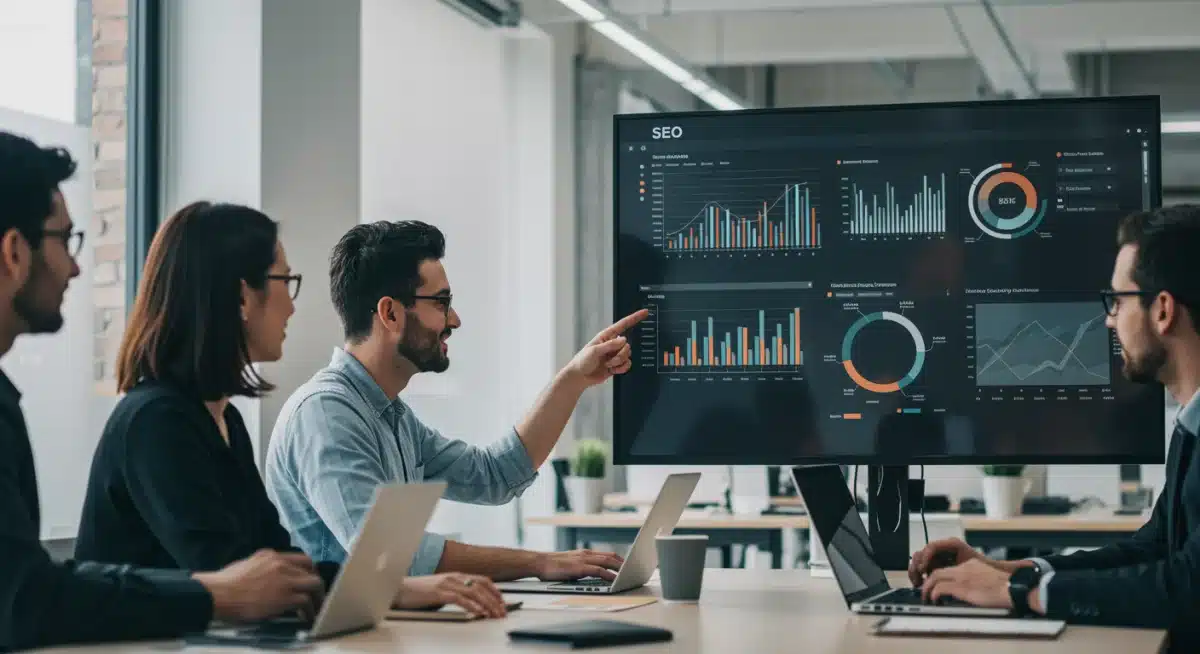Google’s Latest Algorithm Update (Jan 2025): US Marketer Guide

Google’s latest algorithm update, rolling out in January 2025, demands immediate attention from US marketers, impacting search rankings and necessitating strategic adjustments for continued online visibility and performance.
The digital marketing landscape is once again shifting as Google’s Latest Algorithm Update (January 2025): What US Marketers Need to Know Now (TIME-SENSITIVE) begins its global rollout. This critical development requires immediate attention from all US marketers aiming to maintain or improve their online presence. Understanding these changes now is paramount to adapting strategies effectively and ensuring sustained search engine visibility.
Understanding the January 2025 Core Update
Google has confirmed a significant core algorithm update for January 2025, with early indicators suggesting a strong focus on enhancing user experience and refining content quality assessments. This update is not merely a minor tweak; it represents a comprehensive re-evaluation of how Google indexes and ranks web content, directly impacting search engine results pages (SERPs) for US-based queries.
Initial reports from early adopters of the update indicate shifts in ranking for various niches, particularly those reliant on informational content and e-commerce platforms. Google’s ongoing commitment to delivering the most relevant and high-quality results to its users drives these periodic, substantial changes. Marketers must move quickly to assess the potential ramifications.
Key Areas of Impact
The January 2025 update appears to be targeting several critical aspects of web content and site performance. Marketers should pay close attention to these areas:
- Content E-E-A-T Signals: Emphasis on Experience, Expertise, Authoritativeness, and Trustworthiness is stronger than ever. Google continues to reward content that demonstrates genuine knowledge and credibility.
- User Engagement Metrics: Signals related to how users interact with a site, such as bounce rate, time on page, and click-through rates, are gaining more weight in ranking algorithms.
- Technical SEO Foundations: Core Web Vitals and overall site speed remain crucial, with Google penalizing sites that offer poor user experiences due to technical deficiencies.
- AI-Generated Content: Refinements in how Google identifies and evaluates AI-generated content are expected, pushing for human oversight and value addition.
The goal is always to reduce spam and low-quality content while promoting valuable, user-centric resources. This update reinforces Google’s long-standing principles but with new, enhanced detection capabilities.
Initial Observations and Data Trends for US Markets
As the January 2025 algorithm update unfolds, preliminary data is emerging, offering a glimpse into its immediate effects on US search rankings. Early analysis by prominent SEO tracking tools indicates a period of volatility, with some websites experiencing significant fluctuations in visibility. This volatility is typical during a core update rollout, as Google’s systems recalibrate and re-evaluate the vast index of web pages.
Specific sectors within the US market, such as health and finance, which are traditionally held to higher E-E-A-T standards, are showing notable shifts. Websites that had previously relied on thin or unverified content are reportedly seeing declines, while those demonstrating strong authoritative signals are either holding steady or improving their positions.
Analyzing Ranking Fluctuations
Marketers should immediately begin monitoring their keyword rankings and organic traffic metrics. Look for:
- Sudden Drops or Spikes: Any dramatic changes in ranking for core keywords could be directly attributable to the update.
- Traffic Source Changes: Observe if organic search traffic from Google is decreasing while other sources remain stable, indicating a search-specific issue.
- SERP Feature Alterations: Note any changes in how your content appears in featured snippets, knowledge panels, or other rich results.
These initial observations are crucial for forming hypotheses about how the update is affecting your specific online properties. Do not jump to conclusions based on a single day’s data, as the rollout can take weeks to fully stabilize.
Strategic Adjustments for Content Optimization
In response to the January 2025 Google algorithm update, US marketers must prioritize strategic adjustments to their content optimization efforts. The emphasis is squarely on creating truly valuable, high-quality content that satisfies user intent and demonstrates clear expertise. This means moving beyond keyword stuffing and focusing on comprehensive, well-researched topics that address user questions thoroughly.
Content audits should become a top priority. Identify pages that are underperforming or could be at risk due to the update’s focus on quality and E-E-A-T. Consider refreshing outdated information, expanding on brief articles, or even consolidating multiple thin pages into one robust resource. Remember, Google rewards depth and authority.
Enhancing Content Quality and E-E-A-T
To align with the update’s direction, focus on these content strategies:
- Authoritative Sourcing: Back up claims with credible sources and link out to reputable external sites where appropriate.
- Expert Authorship: Ensure content is written or reviewed by individuals with demonstrable expertise in the subject matter. Clearly display author bios with credentials.
- Original Research & Insights: Prioritize unique data, original analysis, and fresh perspectives that add genuine value beyond what’s already available.
- User-Centric Design: Structure content for readability, using clear headings, short paragraphs, and multimedia to enhance the user experience.
The goal is to produce content that Google’s algorithm recognizes as a definitive and trustworthy resource for users, thereby improving its chances of ranking well in the evolving search landscape.
Technical SEO Imperatives Post-Update
While content quality often takes center stage during algorithm discussions, the January 2025 update underscores the enduring importance of robust technical SEO. A technically sound website provides a strong foundation for any content strategy, ensuring that Google can efficiently crawl, index, and understand your pages. Poor technical performance can undermine even the most expertly crafted content, especially with Google’s continued emphasis on user experience.
US marketers need to conduct thorough technical audits to identify and rectify any underlying issues. This includes evaluating site speed, mobile-friendliness, crawlability, and indexability. The Core Web Vitals metrics remain a critical benchmark, and sites that fail to meet these standards may find themselves at a disadvantage in the competitive post-update environment.
Key Technical SEO Checks
Address these technical aspects immediately:
- Core Web Vitals Optimization: Improve Largest Contentful Paint (LCP), First Input Delay (FID), and Cumulative Layout Shift (CLS) scores.
- Mobile Responsiveness: Ensure your website offers a seamless and fast experience across all mobile devices. Google’s mobile-first indexing strategy means this is non-negotiable.
- Site Speed Enhancements: Optimize images, leverage browser caching, and consider using a Content Delivery Network (CDN) to reduce load times.
- Crawlability & Indexability: Review your robots.txt file and sitemaps to ensure Googlebot can access and index all important pages without hindrance.


A holistic approach to technical SEO, combined with high-quality content, will provide the best defense against negative impacts from the update and position your site for long-term success.
Local SEO Considerations for US Businesses
For US businesses operating with a physical presence or targeting specific geographic areas, the January 2025 algorithm update also carries significant local SEO implications. Google’s continuous efforts to provide hyper-relevant search results mean that local ranking factors are constantly being refined. Businesses must ensure their local online profiles are optimized and consistently managed to capture local search traffic effectively.
The update may influence how local packs and Google Maps results are generated, potentially favoring businesses with more comprehensive and verified local information. Customer reviews and local citations, already important, are likely to play an even more critical role in establishing local authority and trust.
Optimizing for Local Search Post-Update
Focus on these local SEO strategies:
- Google Business Profile (GBP) Optimization: Ensure your GBP listing is complete, accurate, and regularly updated with business hours, services, photos, and posts.
- Consistent NAP Information: Maintain consistent Name, Address, and Phone (NAP) information across all online directories and your website.
- Encourage & Respond to Reviews: Actively solicit customer reviews and respond to all feedback, both positive and negative, demonstrating engagement and customer service.
- Local Content Creation: Develop content that speaks to local events, news, or community interests, establishing your business as a local expert.
Neglecting local SEO during this period of algorithmic change could lead to a loss of visibility for businesses heavily reliant on local customer bases. Proactive management of your local digital footprint is essential.
Monitoring and Adapting to Ongoing Changes
The rollout of Google’s January 2025 algorithm update is an ongoing process, and its full effects may not be immediately apparent. US marketers must adopt a continuous monitoring and adaptation strategy to navigate this period successfully. SEO is not a static endeavor; it requires constant vigilance and a willingness to adjust tactics based on performance data and emerging trends. Relying on outdated strategies will inevitably lead to diminishing returns.
Establish robust tracking mechanisms for key performance indicators (KPIs) such as organic traffic, keyword rankings, conversion rates from organic search, and user engagement metrics. Leverage analytics tools to identify patterns and pinpoint pages or content types that are most affected by the update. This data-driven approach will inform your necessary adjustments.
Essential Monitoring Practices
Implement these practices for effective adaptation:
- Daily Ranking Checks: Utilize SEO tools to track the daily performance of your most important keywords.
- Google Search Console Analysis: Regularly check Search Console for crawl errors, index coverage issues, and performance reports to understand how Google views your site.
- Competitor Analysis: Monitor changes in competitor rankings and strategies to identify successful adaptations or new opportunities.
- Stay Informed: Follow reputable SEO news sources and official Google announcements for further insights and updates on the algorithm’s behavior.
The ability to quickly identify changes, analyze their impact, and implement corrective measures will be the hallmark of successful marketers in the post-January 2025 landscape. Agility and responsiveness are key.
| Key Impact Area | Brief Description of Change |
|---|---|
| Content E-E-A-T | Increased emphasis on Experience, Expertise, Authoritativeness, and Trustworthiness in content. |
| Technical SEO | Continued importance of Core Web Vitals and site speed for user experience and ranking. |
| Local Search | Refinements impacting local pack and Maps results; GBP optimization is crucial. |
| AI Content Evaluation | Enhanced detection and evaluation of AI-generated content, favoring human oversight. |
Frequently Asked Questions About Google’s January 2025 Update
The primary focus of Google’s January 2025 algorithm update is to significantly enhance content quality and user experience. It reinforces the importance of E-E-A-T (Experience, Expertise, Authoritativeness, Trustworthiness) signals, aiming to reward websites that provide genuinely valuable and credible information to users.
US marketers may experience shifts in search rankings and organic traffic, particularly in sectors requiring high trustworthiness like health and finance. The update necessitates a review of content strategies, technical SEO, and local SEO efforts to maintain visibility and adapt to Google’s refined ranking signals.
E-E-A-T stands for Experience, Expertise, Authoritativeness, and Trustworthiness. It’s more crucial now as Google refines its ability to identify and reward content created by genuine experts with real-world experience, ensuring users receive reliable and high-quality information, especially for YMYL topics.
Yes, marketers should be aware that Google is improving its evaluation of AI-generated content. While not inherently penalized, content lacking human oversight, originality, or genuine value may struggle to rank. Focus on using AI as a tool to enhance, not replace, human expertise and creativity.
Immediately conduct a comprehensive content audit focusing on E-E-A-T, optimize Core Web Vitals and technical SEO, and thoroughly review and update Google Business Profile listings for local search. Continuous monitoring of ranking and traffic fluctuations is also essential for timely adjustments.
What Happens Next
The January 2025 Google algorithm update is currently in its rollout phase, and US marketers should anticipate continued volatility in search results over the coming weeks. Google typically takes several weeks to fully deploy core updates, meaning the landscape will continue to settle and reveal its full implications. Marketers must remain agile, relying on real-time data and official communications from Google to inform their strategies. The long-term trend points toward an ever-increasing demand for high-quality, user-centric content backed by strong technical foundations and demonstrable expertise. Those who prioritize genuine value and continuous adaptation will be best positioned for success in this evolving search environment.





